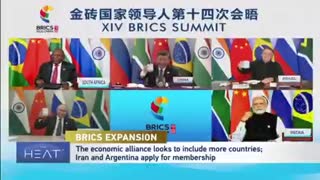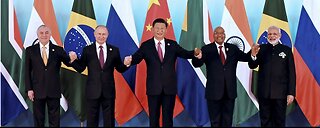David Sacks analysis on BRICS adding Argentina, Egypt, Ethiopia, Iran, Saudi Arabia, UAE
.@DavidSacks analysis on BRICS adding Argentina, Egypt, Ethiopia, Iran, Saudi Arabia, and the UAE.
1. In terms of global GDP based on purchasing power parity, the original BRICS accounted for 32%, while the expanded BRICS now stands at 37%, surpassing the G7's 30%. More countries expressing interest could push BRICS' share to 45%.
2. The new BRICS collectively produces 54% of global oil, nearly double the G7's output, with the US remaining the top oil producer. If Venezuela, Algeria, and Kazakhstan join, BRICS could control 90% of global oil and gas trade.
3. BRICS boasts five of the world's six largest food producers: China, Brazil, India, Argentina, and Russia.
4. BRICS represents 46% of the global population and 36% of the global landmass. It also influences vital trade routes, including the Arctic sea route, offering a faster alternative to traditional paths via the Suez Canal.
5. BRICS aims to facilitate trade among its members using local currencies, not to establish a new reserve currency, but to reduce reliance on the US dollar in global trade, ensuring economic sovereignty.
6. BRICS has established key transportation corridors, such as a north-south route connecting Russia, Iran, and India and an east-west corridor through the Belt and Road initiative, encompassing the Persian Gulf, Red Sea, and Suez Canal.
7. These changes in BRICS' role in global trade routes have significant geostrategic implications, allowing it to bypass critical chokepoints and counter US efforts to encircle China.
In essence, BRICS seeks to settle global trade flows independently of the US dollar complex and reduce dependence on the dollar and SWIFT for international transactions.
https://twitter.com/KanekoaTheGreat/status/1698787208352907305
@KanekoaTheGreat
-
 12:01
12:01
ProgressiveTruthSeekers
4 months agoBRICS 2023 EXPANSION: UAE, Saudi Arabia, Iran, Egypt, Ethiopia and Argentina Join The Bloc
7913 -
 3:33
3:33
Mike Martins Channel
7 months agoWhat dose Javier Milei and Jair Bolsonaro know about the Brics Nations and didn't want to join
1271 -
 13:11
13:11
The Geopolitics in Conflict Show
1 year ago $0.03 earnedSaudis Will Join BRICS: DESTROYING US Dollar Global Dominance!!
220 -
 2:16
2:16
Last World News Channel
1 year agoChina supports BRICS expansion with Saudi Arabia as potential new member
25 -
 21:11
21:11
ProgressiveTruthSeekers
6 months agoSaudi Arabia Officially Joins BRICS, XRP Price - Ripple/XRP-New U.S. Bill Traps The Fed/CBDC
717 -
 1:34
1:34
TCcurry
1 year agoGOLD-BACKED, QFS, BRICS COUNTRIES JOINED/JOINING
122 -
 19:11
19:11
Laura's View and Tarot, Too
6 months agoPutin, Saudi Arabia, BRICS
3.93K14 -
 26:24
26:24
FinancialAlmanac
11 months agoSaudi Arabia Joins BRICS & U.S. Loses Petrodollar Partnership?
13 -
 4:46
4:46
Ferrari27
4 months agoThe Impact of New Players on Strategic Balances in Africa and the Middle East
1 -
 3:38
3:38
DonnahueGeorge
1 year agoSaudia Arabia & UAE wants to join BRICS this could devalue US dollar and help AMC GME MOASS
4